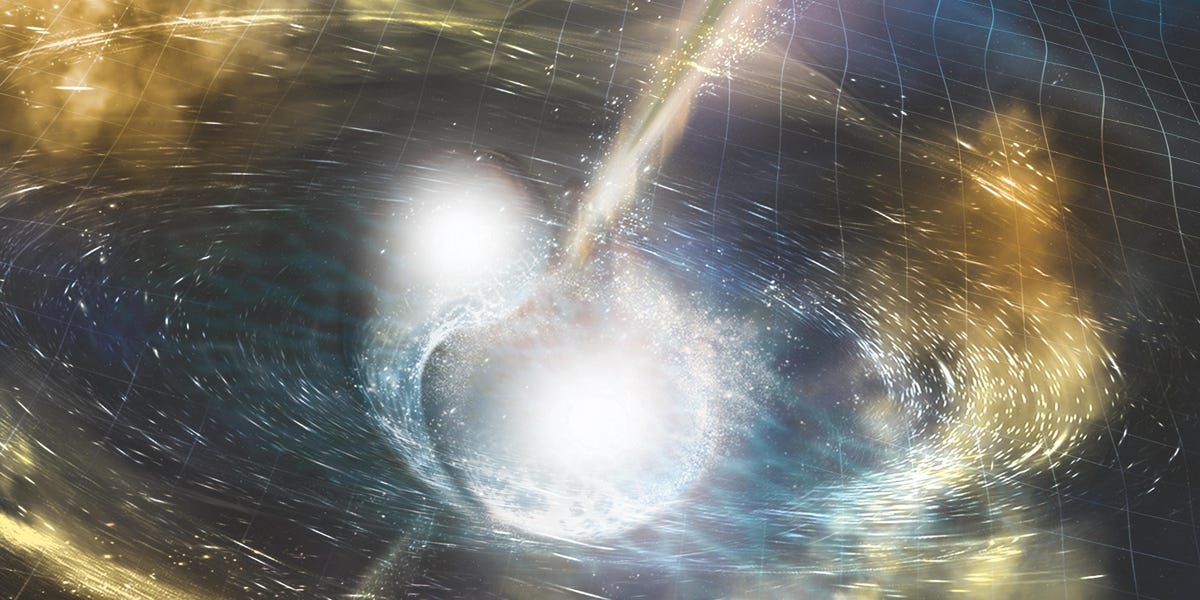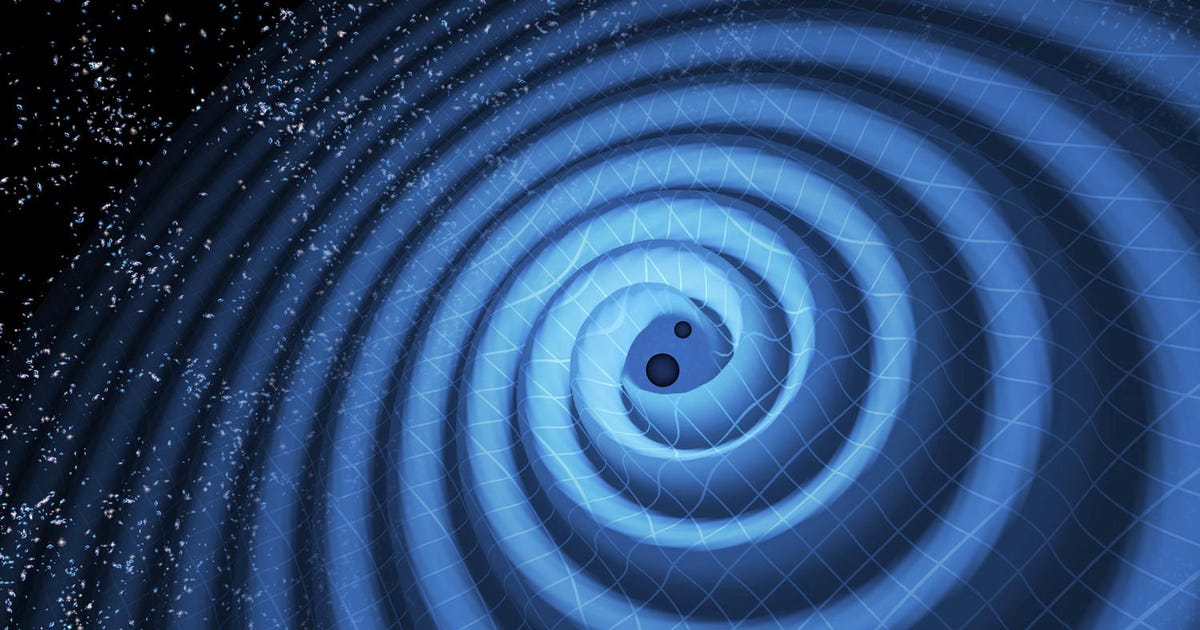Wobbling Black Hole Collision or Detector Glitch? Astrophysicists Puzzled by Extreme Result
Black hole collisions are some of the most extreme phenomena in the universe. As the two dark bodies spiral toward each other, they disturb the fabric of spacetime, sending out ripples across the universe. Those ripples — gravitational waves — eventually wash through the Earth, where some very sensitive detectors in the US, Italy and Japan can “hear” them.
One such ripple washed over our planet in the early hours of Jan. 29, 2020. It was picked up by the dual detectors of the Laser Interferometer Gravitational-Wave Observatory (LIGO) in the US and a third detector, Virgo, in Italy. The detectors’ characteristic chirp suggested a pair of black holes, one that was around 40 times the mass of the sun and the other 22 times, had smashed together.
In a new study, published on Wednesday in the journal Nature, researchers examined the wave from this collision, dubbed GW200129, which — when first discovered — showed a peculiar signal. The wave’s chirp seemed to suggest the black holes that crashed into each other were “wobbling” around in their orbit. This wobble is, scientifically, known as “precession,” and it would be the first time we’ve seen this effect in black holes.
However, other gravitational wave scientists aren’t so certain the signal provides proof of this phenomenon. Instead, they have wondered whether the data may be affected by a glitch in one of the gravitational wave detectors that first spotted GW200129.
What’s happening with GW200129?
First, let’s talk about that “wobble.” To visualize precession, think of the Earth orbiting the sun. You likely imagine our tiny, blue-green planet rotating around the big, hot ball of gas on a flat plane. The planet moves around the sun without deviating “up” or “down.” It just moves around the sun like a racecar on the Daytona 500 circuit. (Let’s not get into the axial precession of Earth here)
In the simulation, you can clearly see the orbital plane shifting as the two black holes orbit each other.
Vijay Varma/Leo Stein/Davide Gerosa.
Two black holes share the same relationship, rotating around each other on a nice, flat orbital plane, shedding energy in the form of gravitational waves as they circle ever closer to one another. But in “precessing” black holes, the orbital plane is distorted over time. Einstein’s seemingly unbreakable theory of general relativity suggests the way individual black holes spin (yes, they spin) can influence precession. When the spins are misaligned, the orbital plane can be rotated.
You can see an example of this produced by Vijay Varma, a Caltech astrophysicist, thanks to a tool he produced in a 2018 paper in the GIF above.
In theory, astrophysicists can “see” precession in binary black holes by studying the gravitational wave signal, but it’s extremely subtle. The authors of the new research believe they’ve captured this elusive sign in the data — discovering a black hole binary that wobbled and tilted all over the place.
“It’s extremely exciting to have finally observed it,” says Mark Hannam, a professor of astrophysics at Cardiff University in the UK and first author on the new study. “This is something we’ve been hoping to observe since the first detections in 2015, both because it’s a general relativity effect we’ve yet to see in the extreme regime of black-hole mergers, and it has the potential to tell us a lot about how black holes form.”
Remember I mentioned black holes can spin? Well, generally, black holes that form when a star collapses spin fairly slowly and without any precession. But black holes that are created by the formation of two other black holes colliding can have quite unusual spins and extreme speeds, which could throw the whole system into disarray. Thus, Hannam notes, “one possibility is that the larger black hole was produced in an earlier merger of two black holes.”
Pretty remarkable, but is it case closed? Not so fast.
Glitch in the space-trix
Though the signal may be interpreted as a pair of wobbling, precessing black holes, other astrophysicists have noted GW200129 could be something far less exciting: An error.
“In the case of GW200129, there was a faint but present glitch in LIGO’s Livingston detector coincident with the event,” said Ethan Payne, an astrophysicist at Caltech. Payne recently authored a preprint article, uploaded to the website arXiv in June, which describes GW200129 as a “curious case” and presents the argument that such a glitch may be affecting the signal.
Gravitational wave detectors can experience glitches and noise that sometimes obscure the signals. Most, Payne said, do not impact our understanding of where a gravitational wave originated. With some finessing, scientists can account for the noise and glitches. This was the case with the very first detection of gravitational waves from two colliding neutron stars, but scientists were able to model and “subtract” out the glitch.

An artist’s impression of two neutron stars colliding, generating gravitational waves and a huge, bright jet.
Caltech/LIGO
In the case of GW200129, another sensor in the gravitational wave detector was used to subtract out the glitch by Hannam in the new study. “The glitch removal may not have been perfect, but it’s extremely unlikely that anything left over could mimic the precession we’ve seen,” said Hannam. He says he’s confident in his team’s result because of all the development that went into preparing the data from the detectors and the checks done on his team’s own analysis.
But uncertainty remains. Payne’s work suggests some of the finessing scientists have done can remove all evidence of the glitch. Other astrophysicists I spoke with suggest the analysis have not fully accounted for this.
“I think it’s exciting work,” said Eric Thrane, an astrophysicist at Monash University in Australia and member of the LIGO-Virgo collaboration who was not affiliated with the research, “but in light of Payne[‘s paper], I’m not sure they have demonstrated what they set out to.”
It should be noted that the process of analyzing the GW200129 signal, determining its precession, writing the new study and having it accepted for publication in Nature takes a long time. Hannam and his co-authors were preparing this piece long before problems with the LIGO glitch were completely resolved. The new paper hasn’t discussed issues raised by the analysis performed by Payne and his team but Hannam notes “their method still needs development.”
This is science in action. One team explains a data point, another provides reasons why we should be cautious about it. For now, astrophysicists I spoke with seem to be leaning away from GW200129 being the first precessing black hole binary we’ve spotted. But it’s only a matter of time before scientists unequivocally see this phenomenon.
The LIGO, Virgo and Kagra detectors are set to start another observing run, the fourth, in early 2023. Over the past two years, the detectors have received significant upgrades which will make them more sensitive, opening up the possibility of detecting even more faint signals from across the cosmos. “We’re likely to observe 200 to 300 more GWs per year, so there’s a good chance that we’ll soon understand these systems much better!” said Hannam.
And with that come further challenges, particularly around sorting through the glitches and noise.
“As the expected number of observations is going to increase as our detectors are improved, the number of events contaminated with glitches will skyrocket, and careful work will be needed to model the glitches,” said Payne.
For all the latest world News Click Here

